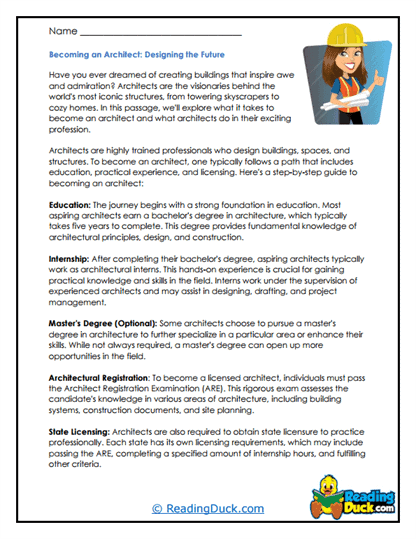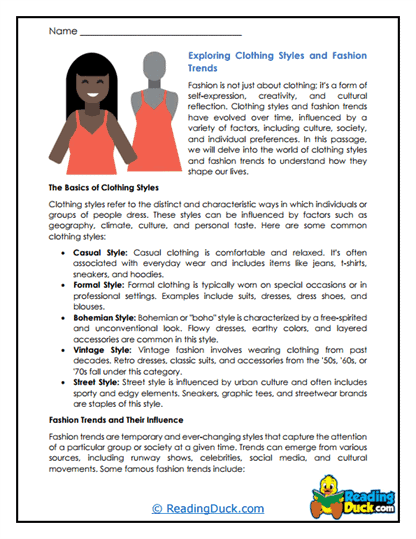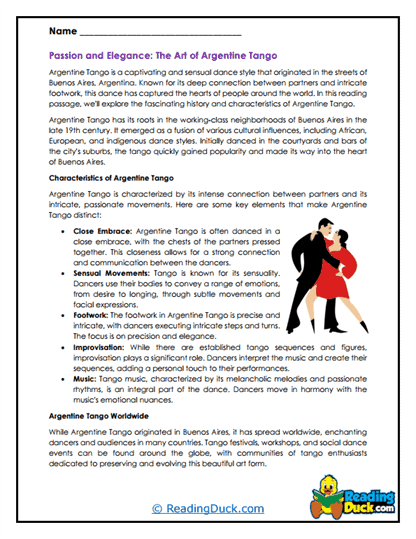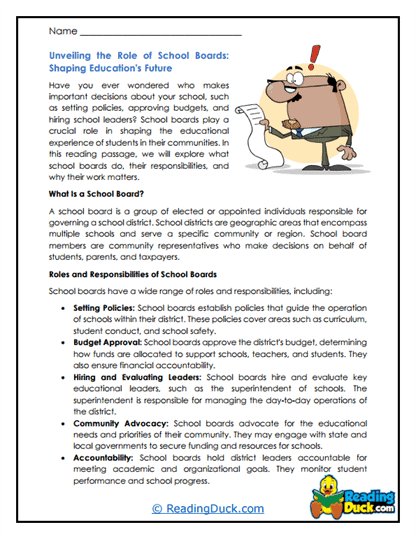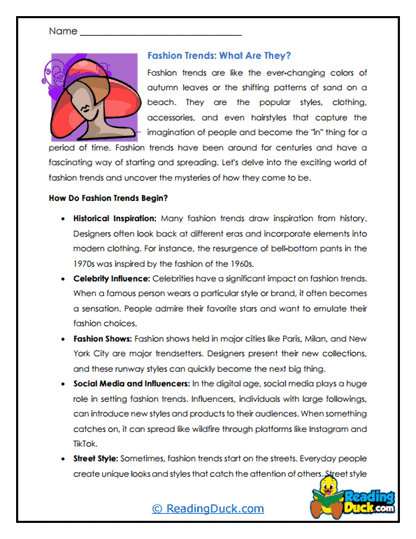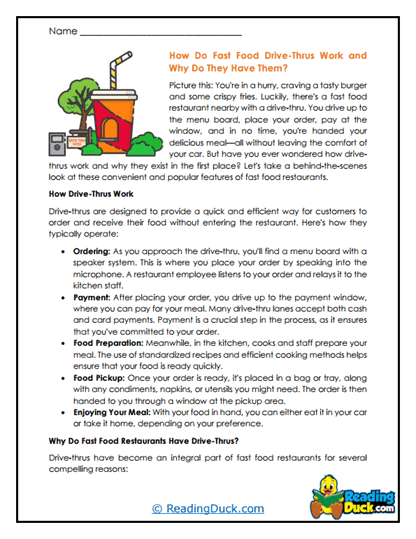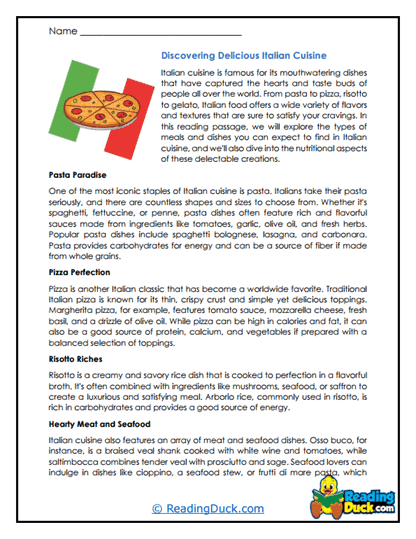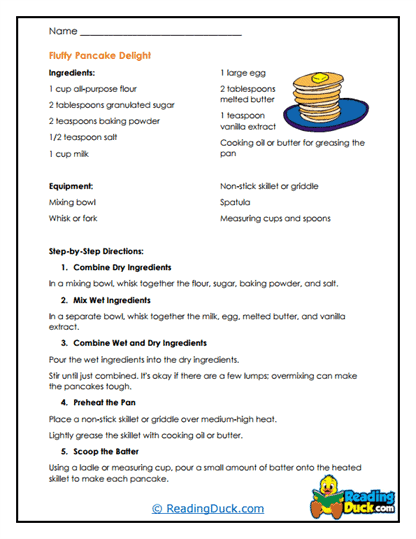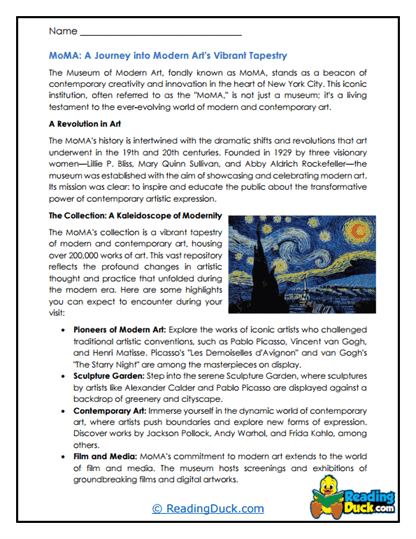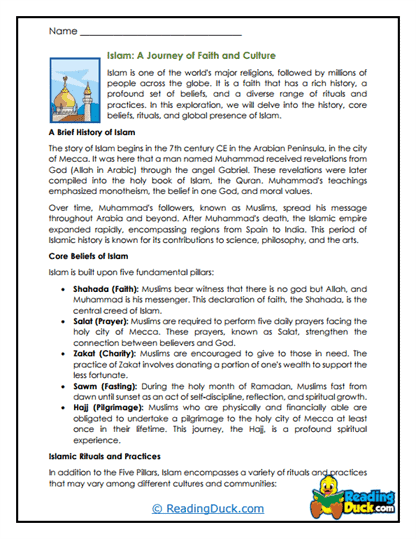Culture Worksheets
About Our Culture Worksheets
Our Culture Worksheets offer an extensive collection of resources designed to deepen students' understanding of key cultural topics.
This collection is thoughtfully organized into categories that reflect different facets of culture, including Architecture, Clothing, Dance Styles, Education, Fashion, Fast Food, Global Cuisine, Making Recipes, Museums, and World Religions. Each category contains multiple worksheet sets, making it easy for teachers to incorporate these topics into their curriculum and for students to explore the rich tapestry of culture.
Each worksheet set begins with a carefully crafted reading passage that provides a detailed overview of the topic at hand. These passages are accompanied by visually engaging and relevant images that enhance the students' connection to the content. The images are chosen not just to attract attention but also to provide context, making the reading more relatable and memorable.
To assess students' comprehension and encourage deeper engagement, each worksheet includes a variety of question formats:
- Multiple Choice Questions: These questions are designed to test students' recall and understanding of key details from the reading passage. Multiple-choice questions help reinforce the main ideas, ensure students grasp essential facts, and offer a straightforward way to evaluate their comprehension.
- Short Answer Questions: These questions require students to express their understanding in their own words, allowing them to delve deeper into the material. By articulating their thoughts and responses, students develop critical thinking skills and improve their ability to summarize and explain complex ideas succinctly.
- Open-Ended Questions: Open-ended questions encourage students to engage with the material on a personal level by offering their own opinions, reflections, or preferences related to the topic. This format fosters creative thinking and helps students make connections between the content and their own experiences or aspirations.
Each worksheet comes with an answer key, making it easy for teachers to quickly assess student progress and provide feedback. Students can also use the answer keys for self-assessment, allowing them to identify areas where they need further understanding.
All worksheets are available as PDF files, which can be easily viewed electronically, downloaded, and printed, ensuring they are accessible for both classroom and at-home learning.
Overview of Topics in This Worksheet Collection
The Culture Reading Comprehension Worksheets are divided into several categories, each representing an essential component of culture. The topics covered in this collection were carefully chosen because they collectively form the foundation of what we understand as "culture."
Each category is explored in depth, not necessarily comparing different cultures but rather focusing on the topic itself. Here’s why we included these specific topics:
- Architecture: Architecture is more than just buildings; it’s a reflection of historical trends, technological advancements, and the creative expression of societies. This category explores the history of architecture, famous architects, various architectural styles, and architecture as a profession. Understanding architecture helps students appreciate how our environments are shaped and the cultural significance behind the structures we often take for granted.
- Clothing: Clothing is a form of cultural expression and identity. This category dives into the history of clothing, the evolution of fashion, and how clothing choices reflect social norms, values, and technological advancements. By studying clothing, students gain insights into how what we wear influences and reflects our cultural and social identity.
- Dance Styles: Dance is a universal language of expression and an integral part of many cultures. This section explores different dance styles, their origins, and their cultural significance. By understanding dance, students learn about the physical and artistic expression of emotions, stories, and cultural values.
- Education: Education is a cornerstone of society, shaping individuals and communities. This category examines different educational philosophies, historical developments in education, and the role of education in cultural and social development. Understanding education helps students see how knowledge is passed down and how it evolves over time to meet the needs of society.
- Fashion: Fashion extends beyond clothing to encompass trends, aesthetics, and cultural symbols. This category explores the fashion industry, influential designers, and how fashion trends reflect and influence society. By studying fashion, students learn about the intersection of creativity, economics, and cultural expression.
- Fast Food: Fast food is a global phenomenon that reflects changes in culture, economy, and lifestyle. This category looks at the history of fast food, its impact on society, and how it has become a symbol of modern culture. Understanding fast food helps students see how culture and commerce intersect in everyday life.
- Global Cuisine: Global cuisine introduces students to the diversity of food traditions around the world. This category explores various cuisines, their cultural significance, and how food connects people to their heritage and to others across the globe. Understanding global cuisine fosters appreciation for culinary diversity and the cultural stories behind what we eat.
- Making Recipes: Cooking is both a practical skill and a cultural tradition. This category focuses on the process of making recipes, the history behind certain dishes, and how recipes are passed down through generations. By learning about recipes, students connect with the cultural and familial traditions that shape culinary practices.
- Museums: Museums are cultural institutions that preserve and showcase history, art, and knowledge. This section explores the role of museums, their history, and how they contribute to cultural preservation and education. Understanding museums helps students appreciate the importance of preserving culture and history for future generations.
- World Religions: Religion plays a significant role in shaping cultures and societies. This category provides an overview of the major world religions, their beliefs, practices, and cultural impact. By studying world religions, students develop an understanding and respect for the diverse spiritual practices that influence cultures globally.
Understanding Culture: Building a Foundation for Lifelong Learning
It is incredibly beneficial for students to develop an understanding of culture as part of their school or learning curriculum. Cultural awareness and appreciation contribute to both academic success and personal growth. Here’s why understanding culture is so important:
- Enhancing Global Awareness: Learning about different aspects of culture helps students develop a broader perspective of the world. It teaches them to appreciate the diversity of human experiences and understand the global context in which we live.
- Developing Empathy and Respect: Studying culture fosters empathy and respect for others. By learning about different cultural practices and beliefs, students are more likely to appreciate and respect the differences that make each culture unique.
- Promoting Critical Thinking: Understanding cultural topics requires students to think critically about how history, society, and individual choices intersect. This encourages analytical thinking and helps students develop a deeper understanding of the world around them.
- Connecting Academic Subjects to Real Life: Cultural studies bridge the gap between academic learning and real-world application. Whether it’s understanding the architecture of a famous landmark or the historical context of a fashion trend, cultural topics make academic subjects more relevant and engaging.
- Inspiring Creativity: Culture is a rich source of inspiration for creativity. By exploring different cultural expressions, students are encouraged to think creatively and apply their learning in new and innovative ways.
- Building Personal Identity: Understanding culture helps students connect with their own cultural background while also appreciating others. This can strengthen their sense of identity and belonging.
- Preparing for a Multicultural World: As our world becomes more interconnected, understanding culture is essential for effective communication and collaboration in diverse environments. Cultural literacy is a key skill for future success in a globalized world.
How Teachers and Parents Can Integrate These Worksheets into a Learning Curriculum
Integrating cultural studies into the curriculum is essential for providing students with a well-rounded education. Here are some practical tips for teachers and parents on how to effectively use these Culture Reading Comprehension Worksheets:
- Tailoring to Grade Levels: Adjust the complexity of the worksheets to suit the grade level of your students. For younger students, focus on the basic concepts and more visual elements of the worksheets, while older students can tackle the more detailed and analytical aspects.
- Connecting with Thematic Units: Use these worksheets as part of thematic units that explore specific cultural aspects. For example, during a unit on global history, the Architecture or World Religions worksheets can provide valuable context and deepen students’ understanding.
- Cross-Curricular Integration: Connect cultural topics to other subjects like art, history, and social studies. For instance, use the Fashion worksheets in a discussion about historical periods, or the Dance Styles worksheets in a physical education class to explore movement.
- Cultural Projects: Encourage students to undertake projects based on the worksheets. After studying Global Cuisine, for example, students could research and present a traditional dish from a particular culture, or create a visual timeline of fashion trends from different eras.
- Class Discussions: Use the open-ended questions from the worksheets to spark classroom discussions or debates. These activities encourage students to share their thoughts and learn to respect diverse viewpoints.
- Cultural Celebrations: Integrate the worksheets into celebrations of cultural diversity, such as International Day or Heritage Month. Students can use the worksheets to learn about and present different cultural traditions.
- Field Trips and Virtual Tours: Complement the worksheets with field trips to local museums, cultural centers, or historical sites. Virtual tours can also be a great way to bring the content to life for students who may not be able to visit these places in person.
- Parental Engagement: Parents can use these worksheets to explore cultural topics at home, creating a shared learning experience that extends beyond the classroom. This can also be a way to connect with and explore the family’s own cultural heritage.
- Creating Cultural Journals: Have students keep a cultural journal where they document their learning, reflections, and personal connections to the material. This ongoing project encourages deeper engagement and helps students track their cultural literacy over time.
By implementing these strategies, teachers and parents can help students gain a deeper understanding of culture, which is essential for their academic success and personal growth. These worksheets not only build reading comprehension but also cultivate a more informed, empathetic, and creative generation.
